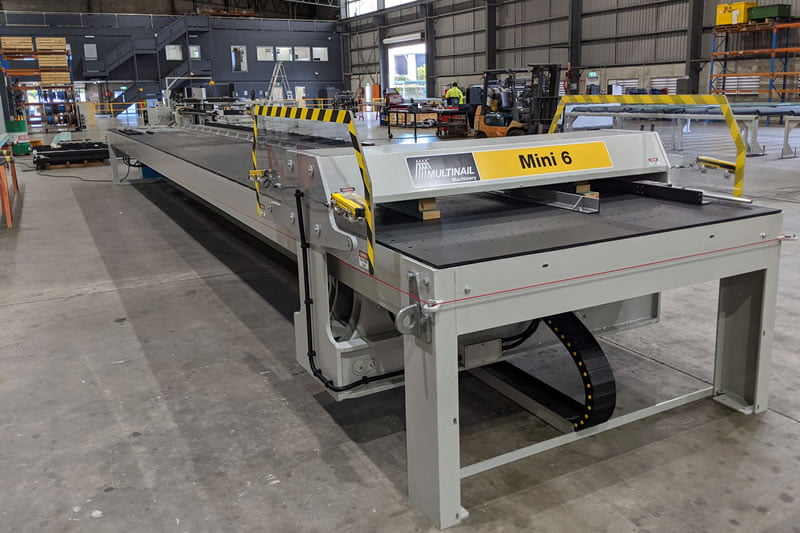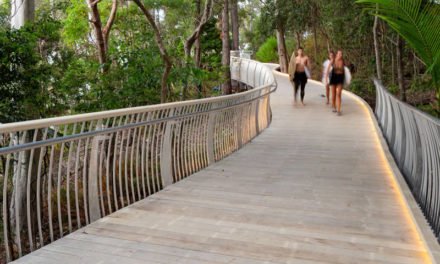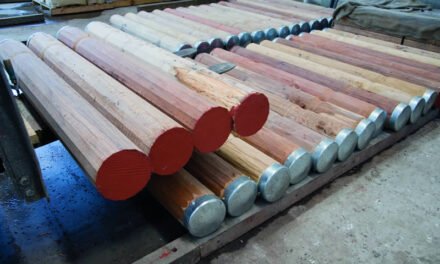In our semi-regular series, experts share advice they wish more people knew. This month, Multinail’s Warwick Porter talks about machines that give the best bang for your buck.
Working as the national machinery sales manager at Multinail, Warwick Porter sees a lot of fabrication plants. And while some of them are big plants operating at high volumes, most are small and medium businesses that are often looking at ways they can improve their productivity and increase their sales.
“Efficiencies are one of the easiest ways to lift productivity,” says Porter, “and they’re often very easy to find, but you have to open to the idea of change and able to invest either money or effort. Money can be easier, so let’s talk about machinery first. Very often, plants can get rid of large inefficiencies by investing in an affordable piece of machinery that both does what they already do better and helps them build new markets.”
Porter says that almost every frame and truss plant can improve its efficiencies across cutting, pressing and wall manufacture, but there’s a big range in prices for those solutions. “So let’s start with one of the cheapest: a table press.”
Low cost, high return
“The cheapest, simplest, easiest to implement solution for increased efficiency in 90% of truss plants that I’ve seen is a small table press,” says Porter.
“The reason for that is that current trends are towards higher density housing, which often results in smaller, lower-pitched trusses that don’t suit the traditional pedestal press manufacturing system we all use. That’s where a small table press fixes your problem. It removes your bottleneck, increases your production, reduces your cost and bumps up your profit.”
For plants using traditional pedestal-type presses, normal A-type triangle trusses generally take around 2-5 minutes to set up and a few minutes to press. On the other hand, low-pitched trusses, which attract a higher price, might take 20-25 minutes to set up and another 5-10 to press.
“On a pedestal press, it’s a lot more work,” says Porter, “but it’s often only about double the price of the A-type truss, yet it took you at least three times as long to make, often considerably more. But if you put it onto a table press, that same low-pitched truss now takes two or three minutes to set up and 30 seconds to press. And it still has the same price when you sell it.”
The gain is even more impressive when you realise that virtually all the unit blocks being built across all our major cities have many low-pitched trusses in them. “So you can sell these trusses in volume,” says Porter. “And that basic premise of 20 minutes on a pedestal versus three minutes on a table – and those are conservative estimates – that’s your saving. That’s where you make your money.”
The same press can be used for multiple other difficult to jig trusses and it doesn’t have special needs for going into a plant.
“It’s all upside, no downside,” Porter says. “There’s no implementation. There are no skills the managers need to acquire. No skill on the floor to run it. Just upside in profit.
“It’s even easy to physically add one to your plant. The table presses we sell start at four feet wide (the Mini 4), so 1.2m, or there’s a six foot one that’s also popular (the Mini 6). And they’re about 10m long, so most people have that sort of space available already with no reorganising.”
Costs are around the $100,000 mark, which is well under the $150,000 limit for the increased instant asset write-off threshold that is in place until 31 December (purchase date).
Wall assembly
For fabricators who produce prefabricated wall frames, the next machine Porter recommends that delivers big bang for your buck is a sub-component nailing system.
“If you’re making walls on a traditional wall line, then you will be able to dramatically improve your efficiencies with a sub-component nailer,” he says.
“It’s an addition that sits to the side of the line and becomes another material flow access point for the line. Instead of all the material flowing in from the end of the line where the operator stands in the console, this machine sits to the side and passes material to him and it does exactly what it says on the label – those components are already assembled.”
The time benefits are readily noticeable. “Some customers have claimed they’ve doubled their previous production when they’ve put a component nailer on their line,” says Porter. “Now they have highly skilled staff, but everyone’s output improves.”
A sub-component nailer does two things. In the first place, it allows you to compensate for natural variations in timber.
“It’s not uncommon for fabricators to be supplied timber that’s a little oversized,” Porter says. “This machine, being highly accurate, allows you to know what that error is and compensate for it. As an example, your nogs can be made smaller by a set amount to compensate for the fact that it’s detected the studs are a bit fatter. You can have the machine automatically shortening up your nogs so that when you assemble the frame, you’re closing that gap up between the studs. The frame is now perfect, and that slight oversize is compensated for quickly and precisely.”
This precision is particularly important on townhouse and mid-rise jobs where uniformity is essential.
“There’s a noticeable visual difference to wall frames made on our machines compared to a standard manually made wall,” says Porter. “They look squarer and straighter, and everything’s ‘right’. They’re visually different in all the little ways of accuracy that add up to a perfect result.”
The second benefit of the machine over the manual process of nailing these sub-assemblies is safety. “It effectively completely removes the operator from that danger zone,” Porter says. “This goes a long way to eliminating the nailing hazard around the sub-assembly process, because the operator is well back from the nail gun. And the machine is also able to keep up that accuracy all day, every day, without the little errors that can creep in when a person gets tired, so you may also reduce the number of nails you use.”
Like the table press, the sub-component nailer models sold by Multinail (the cheekily named Nocking Station and the Component Nailer) are both around the $100,000 mark.
“If you’re already making wall frames in your plant and you add this machine, then you’re going to recoup that investment quickly,” Porter says. “A common number is 35m of manufactured wall per shift per person on the line. You can expect to considerably increase that if you put a sub-component nailer on. Not everyone will double their figures, because not everyone has that specialty skilled workforce. But at a minimum, you’re looking at a 30% increase per person per day, and the majority of our customers achieve more than this depending on their staff capabilities and work styles.”
Roll it in
For his final machinery solution, Porter suggests a Jack Roller. “It’s a roller press like Grandma’s old clothes mangle and it’s either 3m or 4.2m wide with worktables in front of it where your workers stand and they staple their jacks, hips, valleys and other non-dimensionally accurate trusses.”
While very upfront that it’s not for every plant, Porter points out that for mid-sized plants that produce a lot of hips and jacks, the roller is a great investment.
He says, “If this is something your plant does, there’s usually lots of them and you probably charge very small amounts for them and you have to find an efficient way to make them. Installing a Jack Roller is about pounding out these small components at one every 30 seconds instead of one every two minutes. With this machine, your operator staples the hips together, sits the plates on them and just pokes them at the roller. It presses the plates in and it’s the best, fastest, most efficient way to make these small, numerous trusses.”
Like Porter’s other suggestions, a Jack Roller doesn’t require a huge cost or space outlay in the plant. “It’s about 5m wide and about 8-9m long,” he says. “It’s a more specialised tool than the others, it will be most useful for a plant that already has a lot of hips and jacks and has a workstation just for those hips and jacks. For those plants, this is your machine!”
The hard conversation
Having outlined the efficiencies that can be found with money, Porter turns to the more difficult set that require consideration. “If you talk to the sort of person who writes business books, they pretend that it’s easy to sit down and consider your logistics, workflows and processes, but it’s not,” he says.
“Partly because it’s really hard to step back and take a look at all of that while you’re busy running the actual plant, and partly because all of those things have been the best option for you at some point in your business’s operation. Some of them still are, but other things have changed organically over time, so you’ve accidentally introduced inefficiencies.”
Unfortunately, there’s no such thing as a Fabrication Plant Feng Shui Designer. Almost every plant is different due to the thousands of things that make it up, from site access to client needs. Which means that even when you decide your needs have evolved and you do need to re-jig your layout, it can be hard to get advice.
“The single biggest thing that most truss plants could improve in is the logistics and timing of material flow around the shed,” Porter says. “The big ones do it very well, and that’s what has helped them to grow. Unfortunately, there’s no service or training course for that. People have to work it out for themselves. It’s not easy and mistakes can cost time and money, so some are reluctant to step away from something that works well for something that may or may not be better.”
He recommends taking notes and photos when you visit open days, trade shows and the like. Talk to your staff about what takes up their time and look for anything being moved more than once or in an inefficient order around the plant. If you’re ordering new machinery or talking to technicians or the sales team about machinery you already own, pump your suppliers for information and any advice they’re happy to offer.
“We visit a lot of plants and we see things that work well and can be translated into other businesses,” says Porter. “It’s a great resource, but it’s not the sort of advice we offer up without being asked, because a lot of the time there’s a valid reason why things are done the way they are, even if that’s just comfort.
“That said, if optimisation has become the most important thing for you – whether because you need to cut back on extra costs or because you’re entering a big growth phase – then the logistics of shifting stuff around is absolutely critical to making all that gear you own or buy work and it’s something that you can look at straight away with no other investment. Optimal logistics are the number one difference between plants that are operating at good productivity and those that are operating at full productivity.”
Making it all work
However you look to increase efficiencies in your plant, the end result is freeing up staff time to either produce more, or produce new product that can meet the changing needs of a currently uncertain market.
“No one knows what’s going to happen in the next couple of years,” Porter says. “We know that construction is too important to the economy for the government to let it wind down too much, but that might mean investment in social housing, education or council buildings rather than residential.
“If you’re able to make comparatively low-cost tweaks that will help you get more of that business, you’ll be well placed to get through this recession. And pretty much every fabricator is able to produce open-panel walls or low-pitched trusses, so they’ll get real value out of investing in a sub-component nailer or a table press. Those machines are big profit makers and they’re very easy for staff to learn how to use.”
Multinail supplies training to the business’s on-site trainers: both safety training and the operational training. Porter says it’s simple to pick up the techniques, even for staff that come from a very manual background, and that the added safety and lower physical strain make them popular units with workers. “Machinery like this isn’t about replacing people, it’s about replacing some of the repetitive work they do,” he says.
“We get used to thinking about plants revolving around investment in saws, because they’re at the heart of the operation. But you don’t need to be spending $300,000 plus on a new saw, you can get a big return for much less than that.”
For more information, call Warwick Porter on 0419 516 918 or email warwick.porter@multinail.com
Image: Installing a small table press like a Mini 6 speeds the production of high-value trusses.











